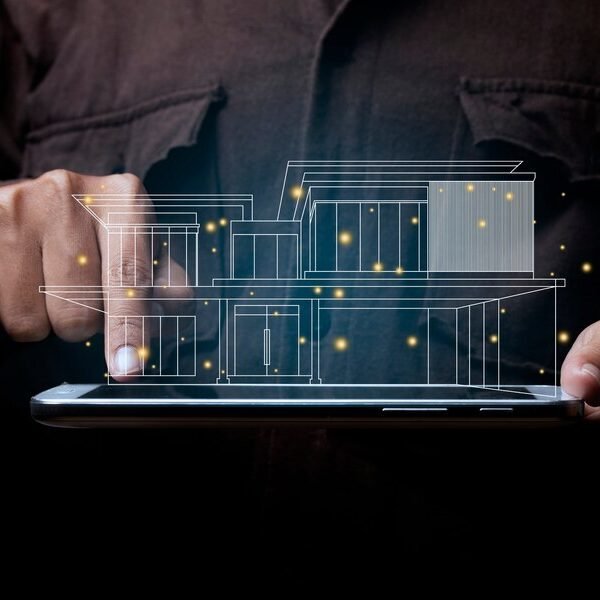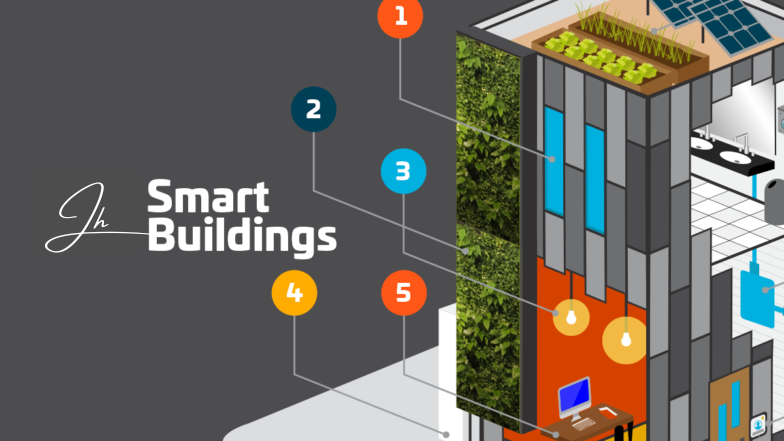The Rise of Smart Buildings: Exploring Technology in Architecture
In today’s world, where technology is making big strides, architecture is changing a lot. The rise of smart buildings stands as a testament to this evolution, merging cutting-edge technology with architectural design to create spaces that are intelligent, efficient, and sustainable. In this blog, we delve into the world of smart buildings, exploring the impact of technology on architectural design and the myriad benefits it brings to the built environment.
Understanding Smart Buildings: A Modern Marvel

Smart buildings are more than just structures; they are intelligent ecosystems equipped with sensors, actuators, and other interconnected devices that collect and analyze data to optimize functionality and enhance user experience. From energy management to security systems, these buildings leverage technology to automate processes, minimize resource consumption, and adapt to the needs of occupants in real-time.
The Evolution of Smart Buildings: From Concept to Reality
The concept of smart buildings has been brewing for decades, with early pioneers envisioning a future where buildings would be seamlessly integrated with technology to enhance efficiency and comfort. Over time, advancements in computing power, connectivity, and sensor technology have turned this vision into reality, paving the way for a new era of architectural innovation.
The emergence of smart building technology has been fueled by a convergence of factors, including the growing demand for sustainability, the rise of the Internet of Things (IoT), and the increasing prevalence of digitalization in all aspects of life. Today, architects and engineers have access to a vast array of tools and technologies that enable them to design and construct buildings that are smarter, greener, and more responsive to the needs of their occupants.
The Impact of Technology on Architectural Design

One of the primary benefits of smart buildings is their ability to optimize energy consumption and resource utilization through integrated systems and automation. From HVAC systems that adjust temperature settings based on occupancy levels to lighting systems that automatically dim or brighten in response to natural light, these buildings are designed to minimize waste and maximize efficiency.
Sustainability is a core principle of smart building design, with architects and developers increasingly turning to renewable energy sources, passive design strategies, and green building materials to minimize environmental impact. By harnessing the power of technology, smart buildings can achieve higher levels of energy efficiency, reduce carbon emissions, and contribute to a more sustainable built environment.
Smart Materials: Revolutionizing Construction and Functionality
In addition to digital technology, smart buildings also leverage advanced materials and construction techniques to enhance functionality and performance. From self-healing concrete that repairs cracks on its own to thermochromic glass that adjusts its opacity based on temperature, these innovative materials are revolutionizing the way buildings are designed, constructed, and operated.
Adaptive Architecture: How Smart Materials Respond to Environmental Changes
One of the key advantages of smart materials is their ability to adapt to changing environmental conditions, enabling buildings to respond dynamically to factors such as temperature, humidity, and sunlight. By incorporating these materials into their designs, architects can create buildings that are more resilient, versatile, and responsive to the needs of their occupants.
Energy Efficiency and Smart Buildings: A Sustainable Approach
Energy efficiency is a cornerstone of smart building design, with architects and engineers employing a variety of strategies to minimize energy consumption and reduce environmental impact. From high-performance insulation and passive solar design to intelligent lighting and HVAC systems, these buildings are designed to operate with maximum efficiency while minimizing their carbon footprint.
The Role of Renewable Energy in Smart Buildings
In addition to reducing energy consumption, smart buildings also harness the power of renewable energy sources such as solar, wind, and geothermal to meet their energy needs. By generating clean, renewable energy on-site, these buildings can reduce their reliance on fossil fuels, lower operating costs, and contribute to a more sustainable energy future.
Connectivity in Smart Buildings: The Internet of Things (IoT) Revolution
Central to the concept of smart buildings is the Internet of Things (IoT), a network of interconnected devices and sensors that communicate with each other to collect and exchange data. From thermostats and light switches to security cameras and occupancy sensors, these IoT devices work together to create a seamless, interconnected ecosystem that enhances the functionality and efficiency of the building.
Enhancing User Experience Through Connected Spaces
By connecting various systems and devices within the building, smart buildings can provide occupants with a more seamless and intuitive user experience. From smartphone apps that allow users to control lighting, temperature, and security systems remotely to interactive displays that provide real-time feedback on energy usage and occupancy levels, these buildings are designed to enhance comfort, convenience, and productivity for their occupants.
The Role of Artificial Intelligence (AI) in Smart Building

Artificial intelligence (AI) plays a crucial role in smart buildings, powering automation systems that streamline operations, optimize energy usage, and improve efficiency. From machine learning algorithms that analyze data to identify patterns and trends to natural language processing systems that enable voice-activated commands, AI technologies are transforming the way buildings are designed, constructed, and operated.
Predictive Maintenance: Anticipating and Preventing Issues
In addition to automation, AI is also used to perform predictive maintenance tasks, enabling building owners and operators to anticipate and address issues before they escalate into costly repairs. By analyzing data from sensors and monitoring systems, AI algorithms can identify potential problems, such as equipment failures or maintenance needs, and alert maintenance personnel to take corrective action proactively.
Data Analytics and Smart Buildings: Harnessing the Power of Information
Data analytics plays a crucial role in smart building management, providing building owners and operators with valuable insights into building performance, energy usage, and occupant behavior. By collecting and analyzing data from sensors, meters, and other sources, building managers can identify opportunities for optimization, detect inefficiencies, and make data-driven decisions to improve building performance and reduce operating costs.
Enhancing Safety and Security Through Data Analytics
In addition to optimizing building performance, data analytics can also be used to enhance safety and security in smart buildings. By analyzing data from security cameras, access control systems, and other sources, building managers can identify potential security threats, monitor occupancy levels, and respond to emergencies more effectively, ensuring the safety and well-being of occupants.
Smart Buildings and User Experience: Designing Spaces for People
One of the key benefits of smart buildings is their ability to create personalized environments that adapt to the preferences and needs of their occupants. From adjustable lighting and temperature settings to customizable workspace layouts and ergonomic furniture, these buildings are designed to enhance comfort, productivity, and well-being for their users.
Promoting Wellness and Comfort in Smart Buildings
In addition to customization, smart buildings also prioritize occupant health and well-being, incorporating features such as daylighting, biophilic design elements, and indoor air quality monitoring systems to create healthy, comfortable indoor environments. By promoting wellness and comfort, these buildings can improve occupant satisfaction, productivity, and overall quality of life.
Challenges and Opportunities in Smart Building Implementation
Despite the many benefits of smart buildings, there are still challenges to overcome in their implementation, including cost considerations, interoperability issues, and concerns about data privacy and security. However, as technology continues to advance and awareness of the benefits of smart buildings grows, these barriers are gradually being overcome, paving the way for widespread adoption and implementation.
Seizing Opportunities for Innovation and Growth
In the face of these challenges, there are also numerous opportunities for innovation and growth in the field of smart buildings. From developing new technologies and materials to exploring new design paradigms and business models, architects, engineers, and developers are constantly pushing the boundaries of what is possible in the built environment, creating opportunities for collaboration, creativity, and positive change.
If you plan to visit an architect, Contact
Conclusion:
The Future of Architecture: Smart, Sustainable, and Connected
As we look to the future of architecture, one thing is clear: smart buildings will play an increasingly central role in shaping the built environment. By harnessing the power of technology, sustainability, and connectivity, these buildings have the potential to revolutionize the way we live, work, and interact with the spaces around us. As architects, engineers, and developers continue to push the boundaries of what is possible, the future of architecture looks bright, smart, sustainable, and connected.


